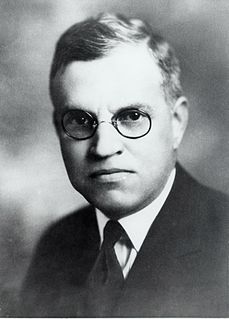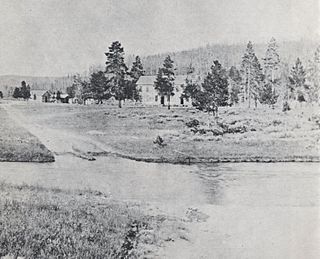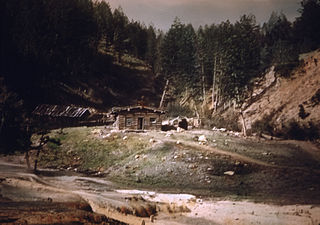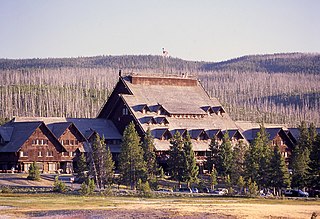Old Faithful is a geyser within Yellowstone National Park.

Robert C. Reamer (1873–1938) was an American architect, most noted for the Old Faithful Inn in Yellowstone National Park.

The Yellowstone fires of 1988 collectively formed the largest wildfire in the recorded history of Yellowstone National Park in the United States. Starting as many smaller individual fires, the flames quickly spread out of control due to drought conditions and increasing winds, combining into one large conflagration which burned for several months. The fires almost destroyed two major visitor destinations and, on September 8, 1988, the entire park closed to all non-emergency personnel for the first time in its history. Only the arrival of cool and moist weather in the late autumn brought the fires to an end. A total of 793,880 acres (3,213 km2), or 36 percent of the park was affected by the wildfires.

The Lake Hotel is one of a series of hotels built to accommodate visitors to Yellowstone National Park in the late 19th and early 20th century. Built originally in 1891, it was re-designed and substantially expanded by Robert Reamer, architect of the Old Faithful Inn in 1903. In contrast to the Old Faithful Inn, the Lake Hotel is a relatively plain clapboarded Colonial Revival structure with three large Ionic porticoes facing Yellowstone Lake.

The Old Faithful Historic District in Yellowstone National Park comprises the built-up portion of the Upper Geyser Basin surrounding the Old Faithful Inn and Old Faithful Geyser. It includes the Old Faithful Inn, designed by Robert Reamer and itself a National Historic Landmark, the upper and lower Hamilton's Stores, the Old Faithful Lodge, designed by Gilbert Stanley Underwood, the Old Faithful Snow Lodge, and a variety of supporting buildings. The Old Faithful Historic District itself lies on the 140-mile Grand Loop Road Historic District.
Hamilton's Stores were concessioners in Yellowstone National Park from 1915 to 2002. The stores were founded by Winnipeg native Charles Hamilton, who arrived in Yellowstone in 1905, aged 21, to work for the Yellowstone Park Association. The stores provided food, souvenirs and sundries to tourists at the major attractions along Yellowstone's Grand Loop Road. Several of the buildings constructed for Hamilton's are significant examples of the National Park Service Rustic style of architecture and have assumed prominence as attractions in their own right. Most or all are included as contributing structures in National Register of Historic Places historic districts.

Old Faithful Lodge in Yellowstone National Park is located opposite the more famous Old Faithful Inn, facing Old Faithful geyser. The Lodge was built as a series of detached buildings through 1923 and was consolidated into one complex by architect Gilbert Stanley Underwood in 1926-27. The Lodge is included in the Old Faithful Historic District.

The Mammoth Hot Springs Historic District in Yellowstone National Park comprises the administrative center for the park. It is composed of two major parts: Fort Yellowstone, the military administrative center between 1886-1918, and now a National Historic Landmark, and a concessions district which provides food, shopping, services, and lodging for park visitors and employees.

The following articles relate to the history, geography, geology, flora, fauna, structures and recreation in Yellowstone National Park.
A Christian Ministry in the National Parks (ACMNP) is the largest and the oldest ecumenical Christian ministry in the United States National Parks, serving since the 1950s.
Dr. Rev. Warren William Ost was the Presbyterian Minister who founded A Christian Ministry in the National Parks (ACMNP) in 1952.

Marshall's Hotel, subsequently known as the Firehole Hotel was the first public accommodations built in the Firehole River geyser basins of Yellowstone National Park and among the earliest tourist hotels in Yellowstone. The first hotel was built in 1880 by George W. Marshall (1838-1917) and his partner John B. Goff and was located just west of confluence of the Firehole River and Nez Perce Creek. A second hotel, the Firehole Hotel, was built in 1884 in partnership with George Graham Henderson very near the present day Nez Perce Picnic area. The hotels operated for eleven years under various ownership ceasing operation in 1891. By 1895, all the structures except a few cabins associated with the two hotels had been razed.
The Old Faithful Museum of Thermal Activity was one of a series of four "trailside" museums built in Yellowstone National Park in 1929. Funded by a grant of $118,000 from Laura Spelman Rockefeller, the museums interpreted park features for visitors, and represented an early version of the visitor information center concept that became widespread throughout the National Park Service. The four museums were notable examples of the National Park Service Rustic style, and all were designed by Park Service architect Herbert Maier. The surviving Norris Museum, Fishing Bridge Museum and the Madison Museum are collectively listed as National Historic Landmarks.

Since before the creation of Yellowstone National Park in 1872, entrepreneurs have established hotels and permanent tourist camps to accommodate visitors to the park. Today, Xanterra Parks and Resorts operates hotel and camping concessions in the park on behalf of the National Park Service. This is a list of hotels and permanent tourist camps that have operated or continue to operate in the park.

Harry W. Child (1857–1931) was an entrepreneur who managed development and ranching companies in southern Montana. He was most notable as a founder and longtime president of the Yellowstone Park Company, which provided accommodation and transportation to visitors to Yellowstone National Park from 1892 to 1980. Child was, with park superintendent and National Park Service administrator Horace Albright, singularly responsible for the development of the park as a tourist destination and for the construction of much of the park's visitor infrastructure.

The Canyon Hotel was built in Yellowstone National Park in 1910 by the Yellowstone Park Company to accommodate visitors to the area of the Grand Canyon of the Yellowstone and Yellowstone Falls. The hotel was built on a huge scale, with a perimeter measurement of one mile. Situated on a hill to the west of the falls, it dominated the landscape. It had an elegant resort-like air when first built. After World War II it was regarded by the National Park Service as outdated. Suffering from neglect, it was abandoned in the late 1950s and was in the process of demolition when it was destroyed by fire in 1960.












